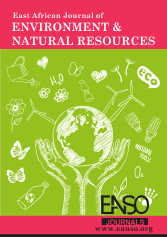Globalization, Urbanization, Energy Consumption, Economic Expansion and Industrialization: Pathway to Tanzania’s Environmental Sustainability Agenda 2030
Ikisiri
This study delves into a comprehensive analysis of interconnectedness between globalization, urbanization, energy consumption, industrialization, and economic expansion as the pathway towards Tanzania’s 2030 environmental sustainability agenda utilizing time series data spanning from 1990 to 2022. This data were sourced from the World Bank (WB) and KOF Swiss Institute. The autoregressive distributed lag (ARDL) model was utilized in this study. Unit root test, ARDL bound cointegration test, Akaike Information Criterion, Serial correlation test, Heteroscedasticity test, and Jarque-Bera test were used for data analysis. The study revealed that the lag of environmental sustainability, industrialization, and economic expansion affects Carbon dioxide (CO2) emissions in the short term by 0.516%, 0.153%, and -0.179% respectively. The study further shows that urbanization increases CO2 emissions by 1.02 percent in the long run, while globalization reduces CO2 by 0.298 percent, which consequently improves environmental sustainability. ECM (Error Correction Mechanisms) suggests 54% speed of adjustment of environmental sustainability within one year after shocks on explanatory variables. The study further recommends an appropriate policy that will encourage conservation of the environment, monitoring and evaluation, technology and innovation of green-friendly energy sources, training and workshops, and community inclusion on matters concerning the environment
Upakuaji
Marejeleo
Acheampong, A. O., & Opoku, E. E. O. (2023). Environmental degradation and economic growth: Investigating linkages and potential pathways. Energy Economics, 123(April), 106734. https://doi.org/10.1016/j.eneco.2023.106734
Ahad, M., & Khan, W. (2017). Does Globalization Impede Environmental Quality in Bangladesh? The Role of Real Economic Activities and Energy Use. Bulletin of Energy Economics, 4(76278), 258– 279. https://mpra.ub.uni-muenchen.de/76278
Brundland, G. (1987). The Brundtland Report: Our Common Future. In Clarendon Press (Vol. 4, Issue 1). https://doi.org/10.1080/07488008808408783
Byaro, M., Mafwolo, G., & Mayaya, H. (2022). Keeping an eye on environmental quality in Tanzania as trade, industrialization, income, and urbanization continue to grow. Environmental Science and Pollution Research, 29(39), 59002–59012. https://doi.org/10.1007/s11356-022-19705-x
IPCC. (2023). Climate Change 2023 Synthesis Report. https://doi.org/10.59327/IPCC/AR6-9789291691647.
Khan, S., & Majeed, M. T. (2023). Toward economic growth without emissions growth: the role of urbanization & industrialization in Pakistan. Journal of Environmental Studies and Sciences, 13(1), 43–58. https://doi.org/10.1007/s13412-022-00797-3
Kivyiro, P. T. (2023). The Causal Links between Urbanization, Energy Use and Carbon Emissions: A Case of SADC Region. Tanzania Journal of Science, 49(2), 503–515. https://doi.org/10.4314/tjs.v49i2.20
Kwakwa, P. A. (2020). The long-run effects of energy use, urbanization and financial development on carbon dioxide emissions. International Journal of Energy Sector Management, 14(6), 1405–1424. https://doi.org/10.1108/IJESM-01-2020-0013
Kyule, B. M., & Wang, X. (2024). Quantifying the link between industrialization, urbanization, and economic growth over Kenya. Frontiers of Architectural Research, 13(4), 799–808. https://doi.org/10.1016/j.foar.2024.03.009
Liu, H., Cui, W., & Zhang, M. (2022). Exploring the causal relationship between urbanization and air pollution: Evidence from China. Sustainable Cities and Society, 80(February). https://doi.org/10.1016/j.scs.2022.103783
Luo, C., Posen, I. D., Hoornweg, D., & MacLean, H. L. (2020). Modelling future patterns of urbanization, residential energy use and greenhouse gas emissions in Dar es Salaam with the Shared Socio-Economic Pathways. Journal of Cleaner Production, 254, 5–49. https://doi.org/10.1016/j.jclepro.2020.119998
Ma, C., & Qamruzzaman, M. (2022). An Asymmetric Nexus between Urbanization and Technological Innovation and Environmental Sustainability in Ethiopia and Egypt: What Is the Role of Renewable Energy? Sustainability, 14(13). https://doi.org/10.3390/su14137639
Mirshojaeian Hosseini, H., & Rahbar, F. (2011). Spatial environmental Kuznets curve for Asian countries: Study of CO 2and PM10. Journal of Environmental Studies, 37(58), 1–14.
Mose, N., Fumey, M., & Kipchirchir, E. (2024). Drivers of Carbon Emissions in Kenya: The Perspective of Technology. Asian Journal of Geographical Research, 7(2), 1–10. https://doi.org/10.9734/ajgr/2024/v7i2226
Nathaniel, S. P. (2020). Modelling urbanization, trade flow, economic growth and energy consumption with regards to the environment in Nigeria. GeoJournal, 85(6), 1499–1513. https://doi.org/10.1007/s10708-019-10034-0
Nathaniel, S. P., & Adeleye, N. (2021). Environmental preservation amidst carbon emissions, energy consumption, and urbanization in selected african countries: Implication for sustainability. Journal of Cleaner Production, 285. https://doi.org/10.1016/j.jclepro.2020.125409
NBS. (2023). Basic Demographic and Socio-Economic Profile (Vol. 4).
NEMC. (2021). National Environmental Policy.
Odugbesan, J. A., & Rjoub, H. (2020). Relationship Among Economic Growth, Energy Consumption, CO2 Emission, and Urbanization: Evidence From MINT Countries. SAGE Open, 10(2). https://doi.org/10.1177/2158244020914648
Omri, A., Euchi, J., Hasaballah, A. H., & Al-Tit, A. (2019). Determinants of environmental sustainability: Evidence from Saudi Arabia. Science of the Total Environment, 657, 1592–1601. https://doi.org/10.1016/j.scitotenv.2018.12.111
Opoku, E. E. O., Acheampong, A. O., & Aluko, O. A. (2024). Impact of rural-urban energy equality on environmental sustainability and the role of governance. Journal of Policy Modeling, 46(2), 304– 335. https://doi.org/10.1016/j.jpolmod.2024.01.004
Pesaran, M. H., Shin, Y., & Smith, R. J. (2001). Bounds testing approaches to the analysis of level relationships. Journal of Applied Econometrics, 16(3), 289–326. https://doi.org/10.1002/jae.616
Raihan, A., & Chandra Voumik, L. (2022). Carbon Emission Dynamics in India Due to Financial Development, Renewable Energy Utilization, Technological Innovation, Economic Growth, and Urbanization. Journal of Environmental Science and Economics, 1(4), 36– 50. https://doi.org/10.56556/jescae.v1i4.412
Rehman, E., & Rehman, S. (2022). Modeling the nexus between carbon emissions, urbanization, population growth, energy consumption, and economic development in Asia: Evidence from grey relational analysis. Energy Reports, 8, 5430–5442. https://doi.org/10.1016/j.egyr.2022.03.179
Saidu Musa, K., Maijama’a, R., & Yakubu, M. (2021). The Causality between Urbanization, Industrialization and Co2 Emissions in Nigeria: Evidence from Toda and Yamamoto Approach. Energy Economics Letters, 8(1), 1– 14. https://doi.org/10.18488/journal.82.2021.81.1.14
Sarkodie, S. A., Owusu, P. A., & Leirvik, T. (2020). Global effect of urban sprawl, industrialization, trade and economic development on carbon dioxide emissions. Environmental Research Letters, 15(3). https://doi.org/10.1088/1748-9326/ab7640
Todd, G., & Mamdani, M. (2017). Tanzania and the Sustainable Development Goals : Has Tanzania Prepaired to roll-out and domesticate the health DSGs?
WB. (2023). Tanzania Economic update: The Efficiency and Effectivenss of Fiscal Policy in Tanzania. In The Word Express (Vol. 78, Issue 10).
Yusuf, A. (2023). Dynamic effects of energy consumption, economic growth, international trade and urbanization on environmental degradation in Nigeria. Energy Strategy Reviews, 50(June), 1–13. https://doi.org/10.1016/j.esr.2023.101228
Zahedi, S. (2019). Sustainable Development Theory: A Critical Perspective and an Integrative Model. Journal of Economics and Sustainable Development, 10(21), 43–52. https://doi.org/10.7176/jesd/10-21-05
Copyright (c) 2024 Seth Kenedi Mbwambo

This work is licensed under a Creative Commons Attribution 4.0 International License.




























